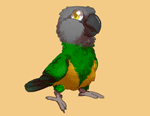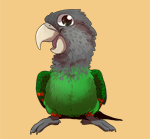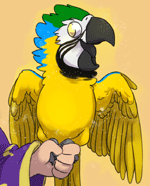 Kili
Type: Senegal Parrot
Genus: Poicephalus
Species: Senegalus
Subspecies: Mesotypus
Sex: Female
Weight: 120 grams
Height: 9 inches
Age: 17 years, 5 months
|
 Truman
Type: Cape Parrot
Genus: Poicephalus
Species:Robustus
Subspecies: Fuscicollis
Sex: Male
Weight: 330 grams
Height: 13 inches
Age: 15 years, 9 months
|
 Rachel
Type: Blue & Gold Macaw
Genus: Ara
Species:ararauna
Sex: Female
Weight: 850 grams
Height: 26 inches
Age: 13 years, 5 months
|
List of Common Parrots:
Parakeets:
Budgerigar (Budgie)
Alexandrine Parakeet
African Ringneck
Indian Ringneck
Monk Parakeet (Quaker Parrot)
Parrotlets:
Mexican Parrotlet
Green Rumped Parrotlet
Blue Winged Parrotlet
Spectacled Parrotlet
Dusky Billed Parrotlet
Pacific Parrotlet
Yellow Faced Parrotlet
Lovebirds:
Peach Faced Lovebird
Masked Lovebird
Fischer's Lovebird
Lilian's (Nyasa) Lovebird
Black Cheeked Lovebird
Madagascar Lovebird
Abyssinian Lovebird
Red Faced Lovebird
Swindern's Lovebird
Lories and Lorikeets:
Rainbow Lorikeet
Conures:
Sun Conure
Jenday Conure
Cherry Headed Conure
Blue Crowned Conure
Mitred Conure
Patagonian Conure
Green Cheeked Conure
Nanday Conure
Caiques:
Black Headed Caique
White Bellied Caique
Poicephalus Parrots:
Senegal Parrot
Meyer's Parrot
Red Bellied Parrot
Brown Headed Parrot
Jardine's Parrot
Cape Parrot
Ruppell's Parrot
Eclectus:
Eclectus Parrot
African Greys:
Congo African Grey (CAG)
Timneh African Grey (TAG)
Amazons:
Blue Fronted Amazon
Yellow Naped Amazon
Yellow Headed Amazon
Orange Winged Amazon
Yellow Crowned Amazon
Cockatoos:
Cockatiel
Galah (Rose Breasted) Cockatoo
Sulphur Crested Cockatoo
Umbrella Cockatoo
Moluccan Cockatoo
Bare Eyed Cockatoo
Goffin's Cockatoo
Macaws:
Red Shouldered (Hahn's) Macaw
Severe Macaw
Blue And Gold Macaw
Blue Throated Macaw
Military Macaw
Red Fronted Macaw
Scarlet Macaw
Green Winged Macaw
Hyacinth Macaw
Glossary of Common Parrot Terms
|
There are many good behaviors that we can teach our parrots but there are just as many (if not more) bad ones we can inadvertently teach that may put our parrots in jeopardy. I have been seeing way too many photos of parrots placed in potentially dangerous situations. Often times the situation isn't dangerous in the moment the photo is snapped but it is teaching the parrot a behavior that is likely to some day get it hurt.
The most common circumstance I've seen in photos that I strongly object to is having a parrot on the stove. In many cases the parrot is actually being trained to go on the stove using operant conditioning through positive reinforcement. People are using the same techniques I use to train my parrots to go to their training perches, but to go to a dangerous place such as a stove instead! Even without food, just the act of laughing, taking a picture, or making a big deal about it can be socially reinforcing in itself. In other words just from someone putting their parrot on a stove and their reaction to it, may encourage the parrot to fly, walk, or jump there on its own some other time.
Even if you are careful not to cook when your parrot is out, which you should be, doesn't mean it's ok to allow the parrot on the stove when it's cold. As the parrot learns that the stove is a safe, fun, and possibly feeding place, not only does it lose deterent from going there but it is even encouraged. Even if you maintain a 100% perfect track record, there is still the possibility of someone else coming over and using the stove while the parrot is out. But not just that. There is also the possibility that your parrot will someday end up in a different home (whether boarding, rehoming, temporary care, etc). If your parrot was encouraged to do potentially dangerous behavior in your home, it could be the end of the bird in someone else's. That is why it is absolutely your responsibility to solve bad behavior and encourage good.
I was originally planning to link photos and stories related to this that I found disturbing but decided I don't want to single anyone out. But I don't want to downplay the severity at all. Believe me, these things are all too common and horror stories are real. The stove is one of the biggest ones that comes to mind but there are plenty of others. Always consider whether or not something could pose a danger to your parrot down the line. Don't encourage that sort of behavior now if it could cause harm later. A good starting point is if you wouldn't allow a toddler to be there or play with that, you especially shouldn't for a parrot!
In my book, I end up talking a lot about encouraging good behavior and cooperation in parrots. But the most important, free, simple, cheap, easy piece of advice I can give toward having a well-behaved/safe parrot is to avoid encouraging bad behavior in the first place! We're not talking about punishing or trying to eradicate bad behavior. We're talking about not giving it the opportunity to develop in the first place. If your parrot is stove obsessed, making it not want to go there is extremely hard and someday the stove may be cooling down and still hot enough to burn the parrot going on there. On the other hand, if you never put your parrot there or allow leftover food to encourage your parrot to go there, you are partly on the way.
Another element to avoiding a parrot from going some place is to never allow it to see you or anyone else there either. For example, my parrots want to chew up my keyboard and things they see me using in their presence. Since I never cook or even approach the stove while they are out, they don't see that as an interesting place. This isn't to say that it's impossible for them to land on the stove, but it makes it damned unlikely because they never saw it as a place birds/people go. It's very hard to keep a parrot from going to places it found to be fun or rewarding. However, preventing it from being rewarding is much more manageable.
So what I encourage you to do, is to think about what kind of household places or things you do may pose a danger to your parrot (not only under your supervision but even under others'). Not only that, don't give your parrot opportunities to play with or chew things that may be dangerous. Prevention is key. Put dangerous items away. Don't allow your parrot into dangerous rooms (such as kitchens/bathrooms). Don't let your parrot see you using potentially dangerous items. Never place reinforcing things (such as food or toys) in potentially dangerous places. And if your parrot does on its own come in contact with something that isn't imminently dangerous (just in the long term), don't make a big deal about it. Don't laugh, don't take a picture, don't give a toy instead, better yet don't do anything. There is a good chance the bird will get bored and that will be the end of that. Almost anything you do will more likely lead to reinforcement of the behavior so no reaction is best.
If the bird takes an interest to a dangerous place (such as a stove) without you reinforcing it, the only remaining solution is to prevent it from being in that room or perform direct training to keep the bird too occupied to have the opportunity to explore unwanted places. For example, place the parrot on a training perch and do some target training to distract if from what it wants to do. Break the bad habit by positively reinforcing a good one. Just remember to prevent and ignore unwanted behavior and then reinforce desirable. For lots more info about achieving a well behaved parrot, check out my book.
Part of: Taming & Basic Training, General Parrot Care, Blog Announcements
Danger Training Reinforcement Book |
|

 Previous Article
Previous Article Next Article
Next Article